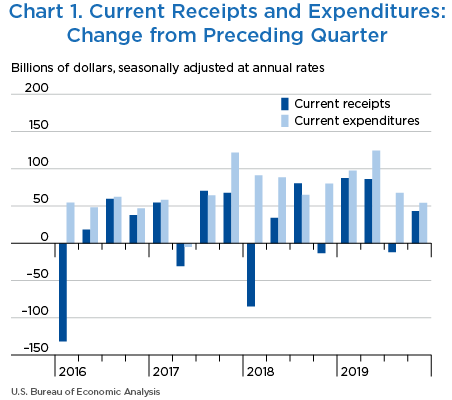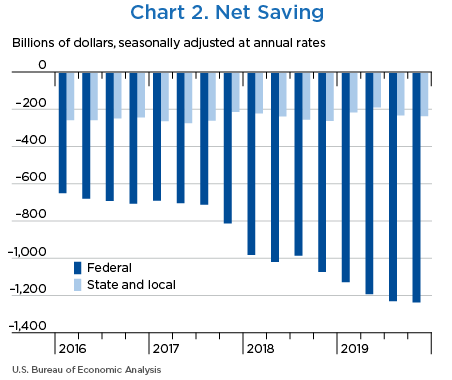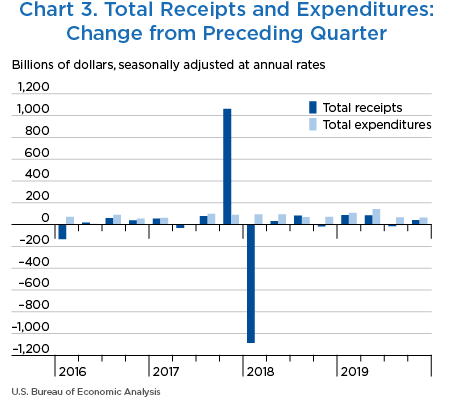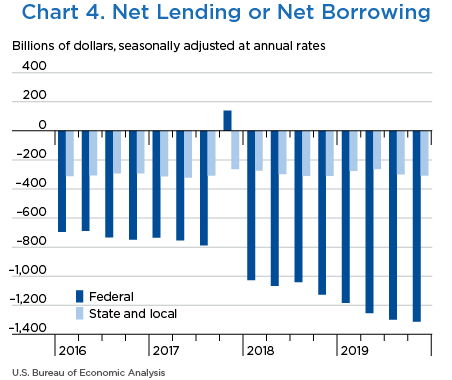Government Receipts and Expenditures
Fourth Quarter of 2019
Net government saving, the difference between current receipts and current expenditures in the federal government and state and local governments, was −$1,463.7 billion in the fourth quarter of 2019, decreasing $11.1 billion from −$1,452.6 billion in the third quarter of 2019 (charts 1 and 2 and table 1).
“Net lending or net borrowing (−)” is an alternative measure of the government fiscal position. Net borrowing is the financing requirement of the government sector, and it is derived as net government saving plus the consumption of fixed capital and net capital transfers received less gross investment and net purchases of nonproduced assets.
Net borrowing was $1,619.4 billion in the fourth quarter, increasing $21.8 billion from $1,597.6 billion in the third quarter (charts 3 and 4 and table 1).
| Line | Level | Change from preceding quarter | ||||
|---|---|---|---|---|---|---|
| 2019 | 2019 | 2019 | 2019 | 2019 | ||
| IV | I | II | III | IV | ||
| 1 | Current receipts | 5,781.2 | 87.3 | 86.1 | −11.8 | 43.0 |
| 2 | Current expenditures | 7,245.0 | 97.5 | 124.5 | 67.7 | 54.3 |
| 3 | Net government saving | −1,463.7 | −10.2 | −38.3 | −79.6 | −11.1 |
| 4 | Federal | −1,232.1 | −55.3 | −65.1 | −37.2 | −6.9 |
| 5 | State and local | −231.7 | 45.1 | 26.7 | −42.4 | −4.3 |
| 6 | Net lending or net borrowing (−) | −1,619.4 | −21.1 | −58.6 | −80.3 | −21.8 |
| 7 | Federal | −1,312.0 | −55.9 | −70.7 | −44.5 | −13.4 |
| 8 | State and local | −307.5 | 34.8 | 12.1 | −35.8 | −8.5 |
Net federal government saving was −$1,232.1 billion in the fourth quarter, decreasing $6.9 billion from −$1,225.2 billion in the third quarter (table 2). In the fourth quarter, both current receipts and current expenditures accelerated.
Federal government net borrowing was $1,312.0 billion in the fourth quarter, increasing $13.4 billion from $1,298.6 billion in the third quarter.
- Personal current taxes (line 3) accelerated in the fourth quarter, reflecting the pattern of wages.
- Taxes on production and imports (line 4) decelerated in the fourth quarter. Customs duties decelerated in the fourth quarter, reflecting a continued, but decelerating, expansion in tariff rates on imports from China.
- Taxes on corporate income (line 5) turned up in the fourth quarter, reflecting an upturn in corporate profits.
- Income receipts on assets (line 8) turned up in the fourth quarter, reflecting an upturn in dividends from the regional Federal Reserve Banks.
- Current transfer receipts (line 9) turned down in the fourth quarter. Third-quarter receipts had been boosted by a $5.0 billion ($20.0 billion at an annual rate) settlement with Facebook for data privacy violations.
- Government social benefits to persons (line 17) accelerated in the fourth quarter, reflecting an acceleration in Social Security benefits.
- Grants-in-aid to state and local governments (line 20) accelerated in the fourth quarter, reflecting an upturn in welfare and social service grants.
- Other current transfer payments to the rest of the world (line 21) accelerated in the fourth quarter.
- Interest payments (line 22) decelerated in the fourth quarter, reflecting a deceleration in interest paid on Treasury Inflation-Protected Securities.
- Subsidies (line 23) turned down in the fourth quarter, reflecting a downturn in agricultural subsidies from the U.S. Department of Agriculture’s Market Facilitation Program, which provides relief from tariffs for certain farm products.
| Line | Level | Change from preceding quarter | ||||
|---|---|---|---|---|---|---|
| 2019 | 2019 | 2019 | 2019 | 2019 | ||
| IV | I | II | III | IV | ||
| 1 | Current receipts | 3,641.7 | 47.7 | 29.6 | 2.0 | 33.4 |
| 2 | Current tax receipts | 2,065.4 | 30.7 | 9.0 | 0.8 | 37.0 |
| 3 | Personal current taxes | 1,718.9 | 54.1 | 3.3 | 7.1 | 20.5 |
| 4 | Taxes on production and imports | 177.1 | −14.2 | −4.4 | 9.8 | 5.6 |
| 5 | Taxes on corporate income | 140.7 | −8.3 | 9.4 | −15.9 | 10.6 |
| 6 | Taxes from the rest of the world | 28.7 | −0.9 | 0.6 | −0.1 | 0.2 |
| 7 | Contributions for government social insurance | 1,415.4 | 39.0 | 8.8 | 4.8 | 11.4 |
| 8 | Income receipts on assets | 104.6 | −18.7 | 13.4 | −22.0 | 6.9 |
| 9 | Current transfer receipts | 63.5 | −1.8 | −0.3 | 18.1 | −22.8 |
| 10 | Current surplus of government enterprises | −7.2 | −1.6 | −1.1 | 0.2 | 0.9 |
| 11 | Current expenditures | 4,873.8 | 103.0 | 94.6 | 39.3 | 40.3 |
| 12 | Consumption expenditures | 1,132.8 | 18.5 | 18.9 | 10.6 | 11.7 |
| 13 | National defense | 687.6 | 14.8 | 10.3 | 3.3 | 7.4 |
| 14 | Nondefense | 445.1 | 3.7 | 8.6 | 7.3 | 4.2 |
| 15 | Current transfer payments | 3,079.7 | 111.4 | 24.7 | 28.3 | 34.0 |
| 16 | Government social benefits | 2,401.9 | 97.3 | 23.5 | 23.4 | 24.6 |
| 17 | To persons | 2,377.6 | 96.5 | 23.1 | 23.0 | 24.5 |
| 18 | To the rest of the world | 24.2 | 0.7 | 0.3 | 0.5 | 0.0 |
| 19 | Other current transfer payments | 677.8 | 14.1 | 1.2 | 4.8 | 9.5 |
| 20 | Grants-in-aid to state and local governments | 616.6 | 15.9 | 13.6 | 0.2 | 2.3 |
| 21 | To the rest of the world | 61.2 | −1.8 | −12.4 | 4.7 | 7.1 |
| 22 | Interest payments | 580.0 | −18.0 | 61.7 | −20.3 | −4.8 |
| 23 | Subsidies | 81.4 | −8.7 | −10.7 | 20.7 | −0.6 |
| 24 | Net federal government saving | −1,232.1 | −55.3 | −65.1 | −37.2 | −6.9 |
| 25 | Social insurance funds | −454.1 | −22.0 | −17.6 | −19.4 | −11.2 |
| 26 | Other | −777.9 | −33.3 | −47.4 | −17.9 | 4.4 |
| Addenda: | ||||||
| 27 | Total receipts | 3,659.1 | 46.8 | 27.8 | 0.7 | 32.5 |
| 28 | Current receipts | 3,641.7 | 47.7 | 29.6 | 2.0 | 33.4 |
| 29 | Capital transfer receipts | 17.4 | −0.9 | −1.7 | −1.4 | −0.9 |
| 30 | Total expenditures | 4,971.1 | 102.7 | 98.6 | 45.1 | 45.9 |
| 31 | Current expenditures | 4,873.8 | 103.0 | 94.6 | 39.3 | 40.3 |
| 32 | Gross government investment | 317.1 | 4.4 | 1.6 | 6.5 | 5.9 |
| 33 | Capital transfer payments | 78.4 | 2.6 | −1.5 | 1.7 | 0.7 |
| 34 | Net purchases of nonproduced assets | −0.9 | −4.4 | 4.5 | 0.1 | 1.3 |
| 35 | Less: Consumption of fixed capital | 297.3 | 2.9 | 0.7 | 2.5 | 2.2 |
| 36 | Net lending or net borrowing (−) | −1,312.0 | −55.9 | −70.7 | −44.5 | −13.4 |
Net state and local government saving was −$231.7 billion in the fourth quarter, decreasing $4.3 billion from −$227.4 billion in the third quarter. In the fourth quarter, current receipts turned up, and current expenditures decelerated (table 3).
State and local government net borrowing was $307.5 billion, increasing $8.5 billion from $299.0 billion in the third quarter.
- Personal current taxes (line 3) decreased less in the fourth quarter, reflecting a smaller decrease in personal income taxes.
- Taxes on production and imports (line 4) decelerated in the fourth quarter, reflecting a deceleration in insurance receipts taxes as well as a deceleration in motor vehicle license and other taxes.
- Taxes on corporate income (line 5) accelerated in the fourth quarter, reflecting an upturn in corporate profits.
- Federal grants-in-aid (line 9) turned up in the fourth quarter, reflecting an upturn in welfare and social service grants.
- Consumption expenditures (line 13) accelerated in the fourth quarter, reflecting an upturn in spending on nondurable goods, specifically petroleum.
- Government social benefits (line 14) turned down in the fourth quarter, reflecting a downturn in Medicaid combined benefits.
- Gross government investment (line 25) turned up in the fourth quarter, reflecting accelerations in investment for structures and equipment.
| Line | Level | Change from preceding quarter | ||||
|---|---|---|---|---|---|---|
| 2019 | 2019 | 2019 | 2019 | 2019 | ||
| IV | I | II | III | IV | ||
| 1 | Current receipts | 2,756.1 | 55.5 | 70.1 | −13.7 | 12.0 |
| 2 | Current tax receipts | 1,889.3 | 42.1 | 53.5 | −13.3 | 9.6 |
| 3 | Personal current taxes | 476.9 | 25.3 | 39.9 | −31.8 | −0.1 |
| 4 | Taxes on production and imports | 1,342.9 | 11.4 | 11.4 | 18.5 | 6.8 |
| 5 | Taxes on corporate income | 69.5 | 5.3 | 2.3 | 0.0 | 2.9 |
| 6 | Contributions for government social insurance | 23.1 | 0.0 | 0.1 | 0.2 | 0.3 |
| 7 | Income receipts on assets | 94.7 | 1.0 | 0.3 | 0.4 | 0.5 |
| 8 | Current transfer receipts | 753.7 | 12.3 | 16.6 | −1.0 | 1.7 |
| 9 | Federal grants-in-aid | 616.6 | 15.9 | 13.6 | 0.2 | 2.3 |
| 10 | Other | 137.1 | −3.5 | 2.9 | −1.2 | −0.6 |
| 11 | Current surplus of government enterprises | −4.5 | 0.0 | −0.3 | 0.0 | 0.1 |
| 12 | Current expenditures | 2,987.8 | 10.3 | 43.5 | 28.6 | 16.3 |
| 13 | Consumption expenditures | 1,930.4 | 0.1 | 21.5 | 15.3 | 17.2 |
| 14 | Government social benefits | 787.7 | 13.2 | 22.3 | 14.0 | −0.3 |
| 15 | Interest payments | 269.0 | −3.0 | −0.4 | −0.6 | −0.7 |
| 16 | Subsidies | 0.6 | 0.0 | 0.0 | 0.0 | 0.0 |
| 17 | Net state and local government saving | −231.7 | 45.1 | 26.7 | −42.4 | −4.3 |
| 18 | Social insurance funds | 5.7 | −0.1 | −0.1 | 0.1 | 0.2 |
| 19 | Other | −237.3 | 45.2 | 26.8 | −42.4 | −4.5 |
| Addenda: | ||||||
| 20 | Total receipts | 2,832.3 | 58.2 | 68.4 | −12.0 | 12.1 |
| 21 | Current receipts | 2,756.1 | 55.5 | 70.1 | −13.7 | 12.0 |
| 22 | Capital transfer receipts | 76.1 | 2.8 | −1.7 | 1.7 | 0.0 |
| 23 | Total expenditures | 3,139.7 | 23.3 | 56.4 | 23.8 | 20.5 |
| 24 | Current expenditures | 2,987.8 | 10.3 | 43.5 | 28.6 | 16.3 |
| 25 | Gross government investment | 433.4 | 15.3 | 17.2 | −1.8 | 6.0 |
| 26 | Capital transfer payments | |||||
| 27 | Net purchases of nonproduced assets | 14.7 | 0.4 | 0.1 | −0.2 | −0.5 |
| 28 | Less: Consumption of fixed capital | 296.1 | 2.8 | 4.3 | 2.7 | 1.4 |
| 29 | Net lending or net borrowing (−) | −307.5 | 34.8 | 12.1 | −35.8 | −8.5 |



